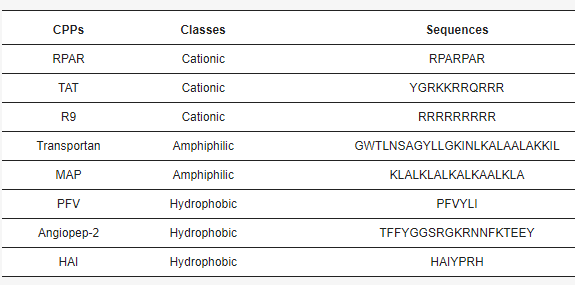
A common strategy for nanomaterials to enter the cell has always been covalent coupling with cell-penetrating peptides (CPPs). While effective, it is not always desirable to make chemical modifications to the nanoparticles. Recently, cationic CPPs have been shown to stimulate cellular uptake of nanoparticles via co-administration. This effect, labeled the bystander manner, allows for nanoparticles to enter the cell with CPPs without chemical modification.
CPPs facilitate Nanoparticle entry into cells
Using CPPs synthesized by LifeTein, scientists wanted to explore if amphiphilic and hydrophobic CPPs were as effective as cationic CPPs at facilitating nanoparticles into the cell via the bystander manner. After testing the peptides used in the table above on mice, they found the amphiphilic Transportation Peptide (TP) was a very effective CPP for increasing the cellular uptake of nanoparticles in this fashion.
Though more research needs to be completed down the line to fully understand all of the components of TP-mediated bystander uptake, this stands as a new and effective method to increase the intracellular delivery efficiency of nanoparticles.
Li, Y.-X.; Wei, Y.; Zhong, R.; Li, L.; Pang, H.-B. Transportan Peptide Stimulates the Nanomaterial Internalization into Mammalian Cells in the Bystander Manner through Macropinocytosis. Pharmaceutics 2021, 13, 552. https://doi.org/10.3390/pharmaceutics13040552
